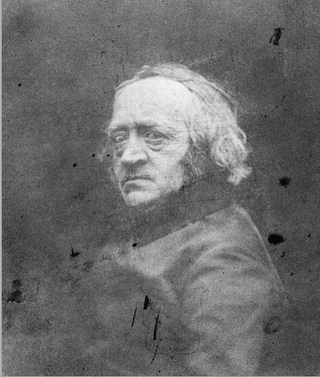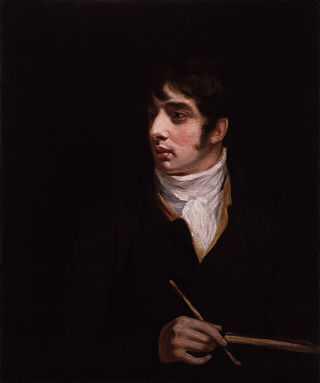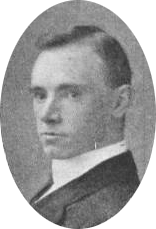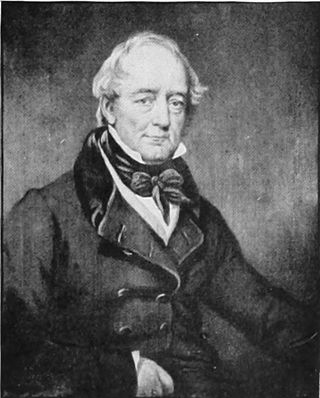
Joseph Mallord William Turner, known in his time as William Turner, was an English Romantic painter, printmaker and watercolourist. He is known for his expressive colouring, imaginative landscapes and turbulent, often violent marine paintings. He left behind more than 550 oil paintings, 2,000 watercolours, and 30,000 works on paper. He was championed by the leading English art critic John Ruskin from 1840, and is today regarded as having elevated landscape painting to an eminence rivalling history painting.

John Sell Cotman was an English marine and landscape painter, etcher, illustrator, and a leading member of the Norwich School of painters.

Thomas Moran was an American painter and printmaker of the Hudson River School in New York whose work often featured the Rocky Mountains. Moran and his family, wife Mary Nimmo Moran and daughter Ruth took residence in New York where he obtained work as an artist. He was a younger brother of the noted marine artist Edward Moran, with whom he shared a studio. A talented illustrator and exquisite colorist, Thomas Moran was hired as an illustrator at Scribner's Monthly. During the late 1860s, he was appointed the chief illustrator for the magazine, a position that helped him launch his career as one of the premier painters of the American landscape, in particular, the American West.

William Henry Hunt, was an English watercolourist. Hunt was "one of the key figures in nineteenth-century English watercolour painting. His work was extensively collected in his lifetime, particularly his genre pictures of children, often in humorous situations, and his detailed, naturalistic still lifes of fruit, flowers, and birds' nests that earned him the nickname ‘Bird’s Nest’ Hunt."

Thomas Girtin was an English watercolourist and etcher. A friend and rival of J. M. W. Turner, Girtin played a key role in establishing watercolour as a reputable art form.

John Martin was an English painter, engraver, and illustrator. He was celebrated for his typically vast and dramatic paintings of religious subjects and fantastic compositions, populated with minute figures placed in imposing landscapes. Martin's paintings, and the prints made from them, enjoyed great success with the general public, with Thomas Lawrence referring to him as "the most popular painter of his day". He was also lambasted by John Ruskin and other critics.

Sir Francis Job Short PPRE was a British printmaker and teacher of printmaking. He revived the practices of mezzotint and pure aquatint, while expanding the expressive power of line in drypoint, etching and engraving. Short also wrote about printmaking to educate a wider public and was President of the Royal Society of Painter Etcher & Engavers from 1910 to 1938. He was a member of the Art Workers' Guild and was elected Master in 1901.
Alfred William Rich was an English artist, teacher and author.

A print room is a room in an art gallery or museum where a collection of old master and modern prints, usually together with drawings, watercolours, and photographs, are held and viewed.

William Turner was a British painter who specialised in watercolour landscapes. He is often known as William Turner of Oxford or just Turner of Oxford to distinguish him from his contemporary, J. M. W. Turner. Many of Turner's paintings depicted the countryside around Oxford. One of his best known pictures is a view of the city of Oxford from Hinksey Hill.

Sir William Russell Flint was a Scottish artist and illustrator who was known especially for his watercolours of women. He also worked in oils, tempera, and printmaking.

William Blake's Illustrations of the Book of Job primarily refers to a series of twenty-two engraved prints by Blake illustrating the biblical Book of Job. It also refers to two earlier sets of watercolours by Blake on the same subject. The engraved Illustrations are considered to be Blake's greatest masterpieces in the medium of engraving, and were also a rare commercial and critical success for Blake.

Charles Turner was an English mezzotint engraver and draughtsman who specialized in portraiture. He collaborated with J. M. W. Turner on the early plates of the same's Liber Studiorum.

Thomas Hearne was an English landscape painter, engraver and illustrator. Hearne's watercolours were typified by applying a wash of subtle subdued colours over a clear outline in fine brush, pen or pencil. His techniques were studied by younger artists such as Thomas Girtin and J. M. W. Turner.

Richard John Spare is a British artist and Master Printmaker known primarily for his drypoints, etchings and oil paintings. He is based in London.

The Liber Veritatis, meaning Book of Truth in Latin, is a book of drawings recording his completed paintings made by Claude Lorrain, known in English as "Claude". Claude was a landscape painter in Rome, who began keeping this record in 1635/6, as he began to be highly successful, and maintained it until his death in 1682. The book is now in the British Museum, and was owned by the Dukes of Devonshire from the 1720s until 1957. It was reproduced in print form from 1774 to 1777 by Richard Earlom and had a considerable influence on British landscape art. The title Liber Veritatis was apparently invented for these reproductions, but is now also used for the original.

In 1842, British artist J. M. W. Turner painted three watercolours of the Rigi, a mountain in the Alps in Central Switzerland, which he had visited the previous summer. Widely regarded as some of his finest works, the watercolours capture the transitory effects of light and atmospheric conditions at the Rigi. According to John Ruskin, "Turner had never made any drawings [watercolours] like these before, and never made any like them again ... He is not showing his hand in these, but his heart."

Fishermen at Sea, sometimes known as the Cholmeley Sea Piece, is an early oil painting by English artist J. M. W. Turner. It was exhibited at the Royal Academy in 1796 and has been owned by the Tate Gallery since 1972. It was the first oil painting by Turner to be exhibited at the Royal Academy. It was praised by contemporary critics and burnished Turner's reputation, both as an oil painter and as a painter of maritime scenes.

Norham Castle, Sunrise is an oil-on-canvas painting by English painter J. M. W. Turner, created around 1845. The painting depicts Norham Castle, overlooking the River Tweed, the border between England and Scotland. The painting was bequeathed to the National Gallery of British Art as part of the Turner Bequest in 1856. It remains in the collection to this day. It was one of the artist's last paintings, and falls within his "Modernist" period. This piece is well known for Turner's attentiveness to dawn light, and the softened silhouette it brings.
Henry Vaughan was a British art collector. He is best known for his many generous gifts and bequests to British and Irish public collections.




















